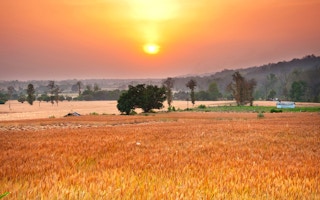Researchers in the UK have established a link between changing climate and agriculture that could have significant consequences for food supplies in South Asia.
They have found evidence of a relationship between rising average temperatures in India and reduced wheat production, which was increasing until about a decade ago but has now stopped.
The researchers, Dr John Duncan, Dr Jadu Dash and Professor Pete Atkinson, all geographers at the University of Southampton, say an intensification is predicted for the recent increases in warmth in India’s main wheat belt that are damaging crop yields.
The greatest impact that the hotter environment has on wheat, they say, comes from a rise in night-time temperatures.
Vulnerability
Dr Dash said: “Our findings highlight the vulnerability of India’s wheat production system to temperature rise. We are sounding an early warning to the problem, which could have serious implications in the future and so needs further investigation.”
The team is the first to use satellite imagery to establish the link between warming and crop yields. The images were taken at weekly intervals, from 2002 to 2007, of the wheat-growing seasons to measure the “vegetation greenness” − an indicator of crop yield.
“
Ten years ago, India’s yield of wheat was increasing. Today, it’s stagnant − and the predictions are that, by 2050, average temperatures will be 5 per cent higher than they are now. This is a wake-up call for the whole of South Asia
Dr Jadu Dash, geographer at University of Southampton
The imagery, of the north-west Indo-Gangetic plain, was taken at such a high resolution that it was able to capture variations in local agricultural practices. The plains stretch over much of northern and eastern India, and into parts of Pakistan, Nepal and Bangladesh.
The data was then compared with climate and temperature information for the area to examine the effect on growth and development of the crop.
The study, published in the journal Global Change Biology, found that warmer temperatures reduced crop yield. Greater warmth during the reproductive and ripening periods, in particular, had “a significant negative impact on productivity”. But it was the warmer nights that did the greatest harm.
In some parts of the Indian wheat belt, growers have been advancing their growing season to make sure that the most sensitive point of the crop growth cycle falls within a cooler period. But in the long term, the researchers say, this will not help, because of the high average temperature rises predicted.
Dr Dash said farmers would have to think seriously about changing to more heat-tolerant wheat varieties. “Currently in India, 213 million people are food insecure and over 100 million are reliant on the national food welfare system, which uses huge quantities of wheat,” he said.
Regular data
“We hope that soon we will be able to examine agricultural practices in even greater detail, with the launch of the European Space Agency’s Sentinel satellites, which will provide regular data at even higher spatial resolution.”
In 2012, India was the world’s second largest wheat producer, with 94.9 million tonnes. It was self-sufficient and able to sell some wheat overseas, although the government has now limited exports.
India’s production was exceeded only by China’s. But China is building up its reserves of wheat, and is now widely seen as working more energetically than many developing countries for an ambitious global climate change agreement.
Dr Dash told the Climate News Network: “Ten years ago, India’s yield of wheat was increasing. Today, it’s stagnant − and the predictions are that, by 2050, average temperatures will be 5 per cent higher than they are now. This is a wake-up call for the whole of South Asia.”








